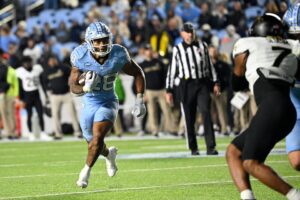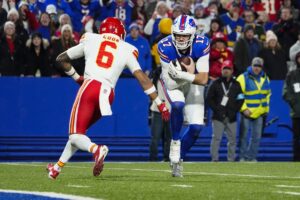Baseball began the revolution. Rudimentary statistics – batting average, runs scored, and runs allowed – began being tracked in the 19th century. Other commonplace statistics such as home runs, runs batted in (RBIs), earned run average (ERA), pitcher wins, and strikeouts began being tracked not long after. Between the early 1900s and the late 1970s, statistics remained primitive. In a time frame where we had progressed from Model T Fords and primitive radio to the Pontiac Firebirds and color television, the ways in which we were analyzing sports were the unchanged. In 1977 Bill James, a rabid baseball fan with degrees in economics and education, published the 1977 Baseball Abstract. This manuscript, which he would reproduce annually, became the jumping off point for the rise of sabermetrics and advanced statistics in baseball.
Now, forty years after the first release of Bill James’ manuscript, baseball has ways of quantifying the wins an individual player is worth (WAR), ways of adjusting data to a certain ballpark, and methods to adjust statistics between different eras of the game. Michael Lewis‘ book Moneyball, and the subsequent Hollywood blockbuster, made sabermetrics sexy. Fangraphs and BaseballProspectus evolved. These entire websites arose solely to analyze baseball statistics, and churn out new stats seemingly every season.
Baseball has always been considered the most individual of team sports. Defined stoppages, easily quantifiable averages, and well-distinguishable eras make it the prime target for advanced scouting. While games are won and lost by teams, players tend to act in a series of more one-on-one interactions, easily creating individual statistics. Since the 1970s, baseball has created new ways to analyze players. On base plus slugging (OPS) came around in 1984; Billy Bean redefined how to build a winning team at the turn of the century. Through all this football essentially remained stagnant.
Football is Becoming a Science: the Rise of NFL Analytics
In the United States, the National Football League garners nearly 42% of the market share between the four major sports (along with baseball, basketball, and hockey). Despite revenues in the 11 figures, football has remained behind the curve in advanced statistical analysis. Bill James was reverse engineering baseball in the 70s. Sites such as Football Outsiders and Advanced Football Analytics (now part of ESPN) didn’t spring up until the mid-2000s.
Where Are We Now?
The average fan is unaware of most of football’s advanced analytics. Win probability models that fail miserably (i.e. Super Bowl VI and the 2016 Election) will erupt on Twitter, but few care to know the math behind them. FiveThirtyEight’s prediction model might get a lot of traffic from fans that want to know what their teams chances of making the playoffs are, but do these fans even care about where these numbers came from?
Multiple websites have evolved to break down every play in every NFL game. Most of these stats are free to the public. Pro Football Focus will break down every play and grade players based on said tape. Websites like NFL Savant break down everything from what side of the field teams throw to more to which gaps teams run through most.
Perhaps the most interesting advanced model in football is the Defensive-adjusted Value Over Average (DVOA) method employed by Football Outsiders. While no site will tell you how their algorithm works, Football Outsiders will at least explain what the goal of the algorithm is. DVOA is essentially a measure of the efficiency of a team compared to league average. It can measure anything from overall team efficiency to the efficiencies of individual offenses, defenses, quarterbacks, offensive and defensive lines, among others.
Comprehending DVOA
Football Outsiders’ Defensive-adjusted Value Over Average is likely the most cited advanced statistic in football. It is also one of the least understood. Many will quote it because it logically makes sense. In 2016, the top four offenses by DVOA were Atlanta, New England, Dallas and Green Bay. These Football Outsiders numbers occasionally mirror our understanding of how football works. However, DVOA takes into account much more than traditional offensive statistics.
DVOA works by measuring the efficiency of each team (or player), reporting said efficiency as a percentage based on average. For example, in 2016, Atlanta had the top ranked offense by DVOA; they were 25.3% better than average. Miami was the closest team to an average offense in the NFL at +0.9%. Both offensive and defensive DVOA ratings are broken down in run and pass variables. In 2016, the top two pass defenses were Denver and Philadelphia. One of the remarkable things of DVOA is it can show you just the separation between Denver’s pass defense and the rest of the league. Denver was 32.9% better than average; Philadelphia (at number two) was 13.6% better than average.
Understandably, Football Outsiders won’t release the math surrounding how they get to their numbers. However, they do make known some of the things taken into account. Most aspects of DVOA take into account both down and distance and location on the field. As noted on their website, “Five yards on third-and-4 are worth more than five yards on first-and-10 and much more than five yards on third-and-12.” Rather logical, no? Additionally, red zone plays are weighted more than plays on your own 40, and all stats are weighted based on the quality of opponent.
Front Office and Organizational Adjustments
In January of 2016 the Cleveland Browns hired Paul DePodesta to be their “chief strategy officer.” DePodesta is a Harvard graduate who worked with Billy Bean and the Oakland Athletics. Made famous by Michael Lewis‘ book Moneyball, he has been working in baseball since 1996. However, DePodesta had no football front office experience.
What DePodesta brought with him was a new approach to scouting. A fresh set of eyes with different experience and an economics background is attempting to make the Browns relevant again. What he has done is change up how teams spend money and acquire assets – a scientific view on team building. He has taken the statistical approach to the draft by increasing the statistical odds of hitting on players. DePodesta has left scouting of players to the team scouts (remember, he has a baseball background). He has simply increased their chances of acquiring impact players by stacking up on picks.
DePodesta saw the Cleveland money situation, and decided to buy draft picks. This had never happened in the NFL. The asset that Cleveland had was a historic amount of cap space. When trading for Brock Osweiler last month, the Browns said that they were willing to pay $16 million of that cap space to obtain an additional second round draft pick.
Moving Forward
In 2017, every NFL team now has some sort of analytics department. However, the number of non-believers is striking. In 2015, former Chargers coach Mike McCoy said “I’m going to go with my gut decision on those things. No one can tell me on a piece of paper this is the right thing or the wrong thing to do.” Similarly, current Chargers offensive coordinator Ken Whisenhunt has been quoted saying he is “not really” buying into analytics.
Football has a ways to go at quantifying the game. Compared to baseball, even basketball, football is living a good ways in the past. Significant improvements are being made to track the game from an analytical aspect. Many front offices and coaching staffs are beginning to buy in. Players will soon follow.
If there’s anything we can say about professional sports, it is that they are results driven. No one would have cared about what Billy Bean was doing in Oakland if they wouldn’t have won back-to-back 102 and 103 win seasons. No one would’ve cared about ‘deflategate’ if the Patriots were a 5-11 team. When a team who fully embraces advanced analytics builds themselves into perennial contenders, that is when football analytics will finally catch on.






